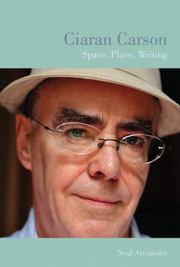Book contents
- Frontmatter
- Contents
- Acknowledgements
- Abbreviations
- Introduction
- Chapter 1 Imaginative Geographies: The Politics and Poetics of Space
- Chapter 2 Mapping Belfast: Urban Cartographies
- Chapter 3 Deviations from the Known Route: Reading, Writing, Walking
- Chapter 4 Revised Versions: Place and Memory
- Chapter 5 Spatial Stories: Narrative and Representation
- Chapter 6 Babel-babble: Language and Translation
- Bibliography
- General Index
- Index of Works
Introduction
- Frontmatter
- Contents
- Acknowledgements
- Abbreviations
- Introduction
- Chapter 1 Imaginative Geographies: The Politics and Poetics of Space
- Chapter 2 Mapping Belfast: Urban Cartographies
- Chapter 3 Deviations from the Known Route: Reading, Writing, Walking
- Chapter 4 Revised Versions: Place and Memory
- Chapter 5 Spatial Stories: Narrative and Representation
- Chapter 6 Babel-babble: Language and Translation
- Bibliography
- General Index
- Index of Works
Summary
The publication in 2008 of Ciaran Carson's Collected Poems, timed to coincide with the poet's sixtieth birthday, is an obvious milestone along the way of his development as a writer. Leafing through its nearly 600 pages, which include work from eight principal collections produced over a period of more than thirty years, the reader is likely to be struck by the extraordinary scope and resourcefulness of Carson's writing. Experimental rather than self-consciously avant-garde, Carson's poetry exhibits a remarkable linguistic inventiveness, formal complexity, and intellectual daring, always making a concerted effort to communicate with the reader yet also foregrounding the resistances that poetic language affords to habitual modes of perception and understanding. His writing often seems intoxicated with the myriad sensations and experiential atoms it attempts to register and record, wielding a microscopic focus upon the particular that freely transmits a MacNeicean awareness of ‘the drunkenness of things being various’ to his readers. Equally vertiginous is his almost paranoiac intuition of concealed patterns and linkages, so that it often appears that an infinity of connections may proceed from a single observation. Carson first made his name as a brilliant anatomist of the city and urban experience, topics that continue to occupy a central role in his aesthetic; but recently he has emerged as a Borgesian miniaturist of the universal, exploring the fractal worlds within worlds created in and by language.
- Type
- Chapter
- Information
- Ciaran CarsonSpace, Place, Writing, pp. 1 - 22Publisher: Liverpool University PressPrint publication year: 2010
- 1
- Cited by



